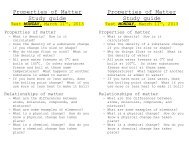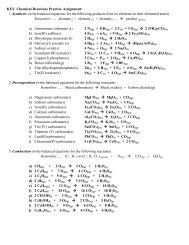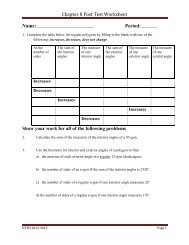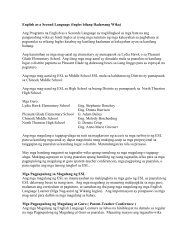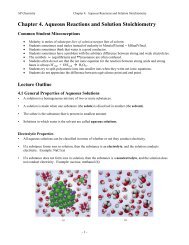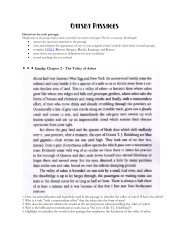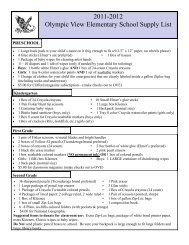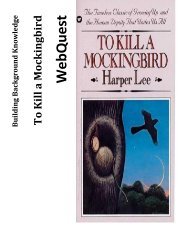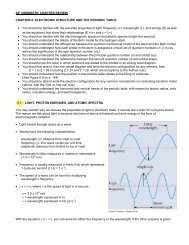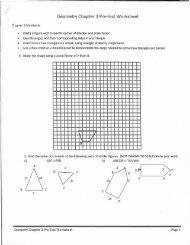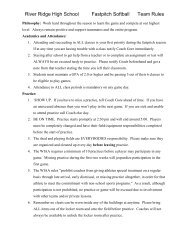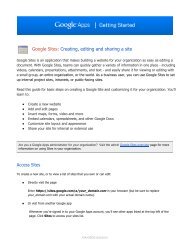Declaration Visual Rubric Declaration Visual Rubric
Declaration Visual Rubric Declaration Visual Rubric
Declaration Visual Rubric Declaration Visual Rubric
Create successful ePaper yourself
Turn your PDF publications into a flip-book with our unique Google optimized e-Paper software.
Name: ________________________________________________________AP Language and Composition, Ms. Doolittle<strong>Declaration</strong> <strong>Visual</strong> <strong>Rubric</strong>Period: __________Date: _______At least three of your peers will grade your <strong>Declaration</strong> <strong>Visual</strong> project. Their scores will be averaged together foryour final grade. Please make sure to look over the comments you receive as well as your final score. The commentsshould help you on future assignments.Exceptional! You met standard in this area (5 points)Adequate. You were close in this area (3 points)Approaching. I can see that you made an effort (2 points)Below Standard. Sorry, but I didn’t see evidence of this at all (1 point)_____ Layout: The text excerpt is written clearly up top, with quotes around the excerpt and a parenthetical citationcontaining the line numbers. The picture is below, and takes up most of the space on the page. The picture is easy tosee (not a faint, sad pencil drawing that requires a magnifying glass)._____ Accuracy of <strong>Visual</strong>: Comparing your visual representation to the line of text increased my comprehensionand clarified my understanding of the line being illustrated. (If you already comprehend the line perfectly, use yourimagination here). I can easily see the connection between the text and the image._____Organization and Care: Product is uncluttered, attention-grabbing, and pleasing to view.Please write comments on back! Comments should address any or all of the following questions as specifically aspossible: what did the student do well? What does the student need to work on? If we were to do this assignmentagain, how could the student preserve his/her high score—or get an even higher one?Peer grade by: _____________________________________________________.Name: ________________________________________________________AP Language and Composition, Ms. Doolittle<strong>Declaration</strong> <strong>Visual</strong> <strong>Rubric</strong>Period: __________Date: _______At least three of your peers will grade your <strong>Declaration</strong> <strong>Visual</strong> project. Their scores will be averaged together foryour final grade. Please make sure to look over the comments you receive as well as your final score. The commentsshould help you on future assignments.Exceptional! You met standard in this area (5 points)Adequate. You were close in this area (3 points)Approaching. I can see that you made an effort (2 points)Below Standard. Sorry, but I didn’t see evidence of this at all (1 point)_______ / 15 total_______ / 15 total_____ Layout: The text excerpt is written clearly up top, with quotes around the excerpt and a parenthetical citationcontaining the line numbers. The picture is below, and takes up most of the space on the page. The picture is easy tosee (not a faint, sad pencil drawing that requires a magnifying glass)._____ Accuracy of <strong>Visual</strong>: Comparing your visual representation to the line of text increased my comprehensionand clarified my understanding of the line being illustrated. (If you already comprehend the line perfectly, use yourimagination here). I can easily see the connection between the text and the image._____Organization and Care: Product is uncluttered, attention-grabbing, and pleasing to view.Please write comments on back! Comments should address any or all of the following questions as specifically aspossible: what did the student do well? What does the student need to work on? If we were to do this assignmentagain, how could the student preserve his/her high score—or get an even higher one?Peer grade by: _____________________________________________________
Name: ______________________________________________________AP Language and Composition, Ms. DoolittlePeriod: _____due date: ____<strong>Declaration</strong> of Independence: AP-style Multiple Choice Questions1) Which of the following indicates the subject and predicate of the first sentence?(A) it becomes(B) bands have connected(C) they should declare(D) respect requires(E) Laws entitle2) The first paragraph (lines 1-9) serves:I. to introduce the main pointsII. as a thesis statementIII. to set the tone(A) II only(B) I and II only(C) I and III only(D) II and III only(E) I,II, and III only3) The organization of the second paragraph ( lines 10-44) could best be described as(A) progressing from general, philosophical ideas to a more specific actual case.(B) beginning with a religious, moral tone and moving to a more personal tone of outrage and indignation.(C) Starting with specific statements of fact gradually changing to more general attacks on government(D) a mixture of factual, specific historical events and more general, religious philosophy(E) a four- part argument, from general to specific, focused on the political philosophy of government.4) Which of the following literary devices is NOT employed in the second paragraph?(A) anaphora(B) complex syntax(C) aphorism(D) parallelism(E) absolutes5) The antecedent for “them” in line 33 is(A) “Governments” (line 24)(B) “mankind”(line 27)(C) “evils”(line 28)(D) “forms” (line 29)(E) “abuses and usurpations” (line 31)6) In the first two paragraphs (prior to the listing of “facts”), Jefferson appeals to each of the followingvalues EXCEPT(A) freedom(B) security(C) economy(D) respect(E) justice
7) The “Facts” mentioned in lines 45-142 are organizedI. from passive to active offenses by the kingII. from smallest to largest offense, political and economic to physical harmIII. from royal offenses to royal approval of Parliament’s offenses and back to royaloffenses(A) II only(B) I and II only(C) I and III only(D) II and III only(E) I, II, and III8) By varying the anaphora in the list of “Facts,” Jefferson(A) shifts the focus from the colonies’ actions to the king’s actions(B) prevents the reader from becoming inured to the evils listed(C) focuses the reader on the results rather than the causes(D) breaks a long list into three smaller distinct parts with different focuses(E) underlines the extent of the damage that has been done9) The listing of the “Facts” in lines 95-119 differs from the listings in lines 45-90 in that lines 95-119(A) employ verbals with much more negative connotations(B) are composed of periodic rather than loose sentences(C) focus on the king’s actions, rather than the results of the actions(D) are more objective and factual and less philosophical(E) attack the military forces of England rather than the king10) The speaker’s purpose in the entire document includes each of the following EXCEPT(A) to describe and define a grave situation(B) to explain the reasons for a serious undertaking(C) to persuade the audience of the necessity for action(D) to appeal to high principles and noble ideals(E) to appeal to a nostalgic reverence for past institutions11) The speaker’s tone might best be described as(A) relaxed and candid(B) impassioned and authoritative(C) complex and ambiguous(D) provocative and sardonic(E) polemical and pedantic
Name: ______________________________________________________AP Language and Composition, Ms. DoolittlePeriod: _____MC Quiz: The <strong>Declaration</strong> of IndependenceSelf-Test:After SOAPs, paraphrasing,and visual. Unlimited time athome1) A B C D E2) A B C D E3) A B C D E4) A B C D E5) A B C D E6) A B C D E7) A B C D E8) A B C D E9) A B C D E10) A B C D E11) A B C D EPartner Test:following protocol1) A B C D E2) A B C D E3) A B C D E4) A B C D E5) A B C D E6) A B C D E7) A B C D E8) A B C D E9) A B C D E10) A B C D E11) A B C D E____/11 = ____%____/11 = ____%Directions: You will need to answer the following questions on the back of your reflection sheet. Use questionnumbering, complete sentences, and clear wording to make it obvious which question you’re answering.1) To deepen our understanding of the <strong>Declaration</strong>, we completed a SOAPS analysis. We also practicedparaphrasing—as a class, in groups, and in pairs or alone. Finally, everyone was assigned a visual for themiddle portion. This involved two activities—creating your visual, and then viewing everyone else’s.a. Of these activities, which had the least impact on your comprehension of the text? Explain.b. Of these activities, which had the most (best) impact on your comprehension of the text? Explain.2) Was it easy to discuss why you chose an answer, without using A, B, C, D, or E? Why or why not? Do youfeel like discussing with a partner made the test easier, or harder? Did your score improve, or go down?How do you think the experience would have been different in a group, as opposed to with a partner? Howwould it be different if the teacher chose your groups or partners, as opposed to letting you pick them?Explain your answers.3) How did labeling the types of questions change your understanding of the quiz? Did you notice any patterns(categories in which you excel, places you need to practice)? Which labeling did you prefer—doing detailedcategory stems, or broad categories? Why? Would this be a valuable activity for you to pursue on your own,or would you only do it if assigned by teacher? Explain your answers.
Types of AP Language & Comp Multiple Choice Questions: Detailed Category Stems 1Device• A shift in point of view is demonstratedby…• “____” can best be said to represent…• The second sentence is unified by thewriter’s use of _____ rhetorical device?• The style of the passage/paragraph can bestbe characterized as…• The phrase/word “____” is an exampleof…• Paragraph “____” uses all of the followingstylistic devices EXCEPT…Grammar & Syntax• The author employs “_____” sentencestructure to establish…• The word “_____” is the antecedent for…• The repetitive syntax of lines “___” servesto…InferenceThe reader can infer “_____” by the way“_____”It may be inferred that, in the next portion ofthe selection…Main Idea• The author would most likely agree withwhich of the following?• The narrator’s/writer’s/ author’s/speaker’sattitude can be described as…• The author would most/least likely agreethat…• The writer has presented all of thefollowing ideas EXCEPT…• We can infer that the author values thequality of…• The attitude of the narrator helps the writercreate a mood of…• In context, lines “_____” most likely referto…Meaning and Purpose• “_____” can best be defined as…• The purpose of lines “_____” can best beinterpreted as…• The writer clarifies “_____” by…• The writer emphasizes “_____” in orderRhetorical Mode• All of the following modes can befound within the passage EXCEPT…• The rhetorical mode that bestdescribes this passage is…• The author uses cause and effectto…• Which of the following best describesthe author’s method of presenting theinformation?• The author combines retrospectionwith which other rhetorical modewithin this passage?Structure and Organization• The shift from “_____” to “_____” isseen by the author’s use of…• In presenting the author’s point, thepassage utilizes all of the followingEXCEPT…• The speaker has included “_____” inher argument in order to…• The type of argument employed bythe author is most similar to which ofthe following?• The passage can be said to movefrom “_____” to “_____”• The “_____” paragraph can be said tobe _____ in relation to “_____”.• The structure of this passage isprimarily one of…ToneIn lines “_____”the tone can best bedescribed as…The tone of the passage changes whenthe writer…VocabularyThe word “_____” (line “_____”) refersto…In context, the word “_____” (line“_____” is best interpreted to mean…1 This page comes from the Kaplan and Cliffs Notes study guides.
to…• By saying “_____”, the author intends forus to understand that…• By “_____”, the author most likelymeans…• The purpose of the sentence/paragraph/phrase can best be summarizedas…• The passage can be interpreted as meaningall of the following EXCEPT…Types of AP Language & Comp Multiple Choice Questions: Broad Categories 2Factual Technical Analytical InferentialSentence StructureStyleGrammaticalPurposeDominantTechniqueImageryPoint of ViewOrganization ofPassageNarrative progressof passageIronyConflictFunction of…Words refer toAntecedentsAllusionsPronounReferencesRhetorical strategyShift indevelopmentRhetorical stanceStyleMetaphorContrastComparisonCause/effectArgumentDescriptionNarrationSpecific-generalGeneral-specificHow something ischaracterizedPassage is primarilyconcerned withFunction of…Effect of dictionToneInferencesEffect of lastparagraphEffect ofdescriptionEffect on readerNarrator’s attitudeImage suggestEffect of detailAuthor impliesAuthor mostconcerned with…SymbolBibliographyMurphy, Barbara and Estelle Rankin. 5 Steps to a 5: AP English Language. United States: McGraw-Hill,2002.Pivarnik-Nova, Denise. AP English Language and Composition. 2008 edition. New York: Kaplan, 2008.Swovelin, Barbara V. CliffsAP: English Language and Composition. 3rd edition. Hoboken: WileyPublishing, Inc, 2006.2 This page comes from 5 Steps to a 5.



